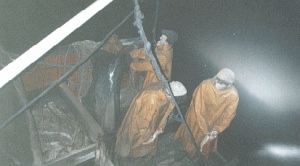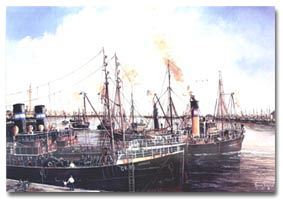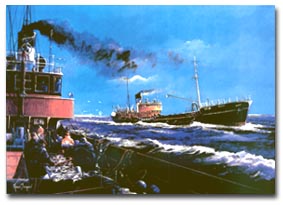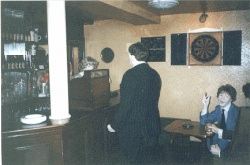Grimsby's origins
are shrouded in the mists of North Sea Legend.Its
founder, a fisherman named Grim, was ordered from Denmark on a mission of murder
- his task to drown the young prince Havelock whose three sisters had already
met their fate at the hands of wicked Earl Godard.Grim could not bring
himself to kill the child but, unable to return, he landed and settled on the
Humber estuary, his home becoming known as Grimsby and his trade establishing
the roots of an industry which would one day make the town famous the world
over. Grimsby has seen many heros since Grim - the men whose way of life was
to endure appalling conditions at sea to bring fish to the markets of Britain;
the men who, by the 1950s had made Grimsby into the world's largest fishing
port - its prosperity founded on the North Sea and deep sea fishing which claimed
so many lives.
Few jobs compare with a three week
trawling trip to the waters of the Arctic.
The crew were on call twenty four hours a day, seven days
a week. Deckhands did much of the hard manual work, gaining their skills through
gruelling experience. This included shooting the trawl gear, a complex job as
the net was made up of many parts. It could be 100 feet long with a conical
shape tampering down its cod-end. This bag was protected from the jagged sea
bed by tough cow hides. There was a network of lines, chains,wires, floats and
bobbins which had to be payed out slowly to avoid a tangled mess. At the other
end of the net were the two trawl doors-otter boards-which acted like under
water kites, keeping the mouth wide open as the net was towed along.After
several hours trawling, the net was hauled in. Once the cod-end was untied,
if the trawl had been successful, thousands of squirming fish were released
into the pounds.

The crew were on call twenty four hours a day, seven days
a week. Deckhands did much of the hard manual work, gaining their skills through
gruelling experience. This included shooting the trawl gear, a complex job as
the net was made up of many parts. It could be 100 feet long with a conical
shape tampering down its cod-end. This bag was protected from the jagged sea
bed by tough cow hides. There was a network of lines, chains,wires, floats and
bobbins which had to be payed out slowly to avoid a tangled mess. At the other
end of the net were the two trawl doors-otter boards-which acted like under
water kites, keeping the mouth wide open as the net was towed along.After
several hours trawling, the net was hauled in. Once the cod-end was untied,
if the trawl had been successful, thousands of squirming fish were released
into the pounds.After several hours trawling, the
net was hauled in. Once the cod-end was untied, if the trawl had been successful,
thousands of squirming fish were released into the pounds.
Trawling involves the dragging of
a net along the sea bed
For much of the nineteenth century, wooden sailing smacks, reliant solely
on the winds and tides ventured only as far as the Faeroe Islands and the
Norwegian Coast for their catches.
Two inventions dramatically changed the fishing industry - steam power and
man - made ice. The former allowing the ships to sail faster, and so to reach
the more distant fishing grounds of Iceland and Greenland, and the latter
providing a way of preserving the fish on board enabling the ships to stay
at sea for weeks on end.
After the second world war, oil burners and diesel electric engines replaced
coal. Navigational equipment was revolutionised by radar, sonar and satellite
communications. Stern trawlers, winching the net up on a ramp at the stern
rather than hauling it over the sidehave replaced the traditional side - winder
vessels. Today, modern freeser trawlers use computers and electronic tracking
devices to detect and follow their catch .Spending months at sea, they rapidly
freeze the catch into blocks on board.

New
fishing methods are constantly being tested - one of the latest involves
shining bright lights at night to attract the fish and sucking them up into
a giant vacuum. With methods like these , it may not be long before traditional
trawl net becomes a thing of the past.
While
the men risked their lives at sea, the woman were left with the stresses and
strains of bringing up families virtually single handed, never knowing whether
their men would return. For every miner killed underground, eight trawlermen
were lost at sea.
Trawler Prints Displayed By Kind Permission Of Lesley Boulter
They Can Be Purchased At Adrian Thompson (Highly Acclaimed
Artist)
Go
there
More fish
It
was now that the deckhands began their real work.
Day and night they gutted the fish, sometimes for over 48 hours without rest-on
a moving deck and exposed to the bitter Artic winter. Many men were swept overboard,
or lost fingers as they sliced through the fish flesh with their razor sharp
knives. Washing the first, they passed them below to be stacked and shelved
in ice in the fish room for the journey home. Only when the last fish was packed
away below and the hatches secured were the exhausted deckhands able to catch
up on their sleep.
The
pressures were hard and having faced such dangers at work, many men released
their tensions at home. With a "sub" from his wife he would meet his
mates in the pub to swop stories and catch up on gossip - this would be a "steady
night". The next morning at 8:00am he joined the crowd of fishermen in
Riby square to "settle up" and collect his free fish.
For
some, that afternoon would be spent drinking heavily and having a bet on the
horses. The luckier wives would be taken out in the evening, usually to the
pub and ending up at a friends house for a late session. Some wives however,
were less fortunate, and while their husbands spent their earnings on gambling
and heavy drinking they spent their time at home alone. For those fishermen
from other ports, life in Grimsby was a difficult time - away from home for
long periods. As a consequence, brawling and prostitution became features of
Freeman Street and Riby Square.
A Fishy Journey





